Dupa plasarea solicitării de comandă, in sectiunea Istoric puteti vedea cate solicitări de comandă mai avem de procesat inaintea dumneavoastra
Program de lucru: Luni - Vineri 9:00 - 18:00, pauza 13:00 - 14:00.
Se efectueaza lucrari de mentenanta la site si pot aparea erori. In cazul in care intampinati erori va rugam sa reincercati mai tarziu.
Ridicarea personala este disponibila pentru comenzile achitate in avans. Se pot ridica dupa ce sunt pregatite.
No products
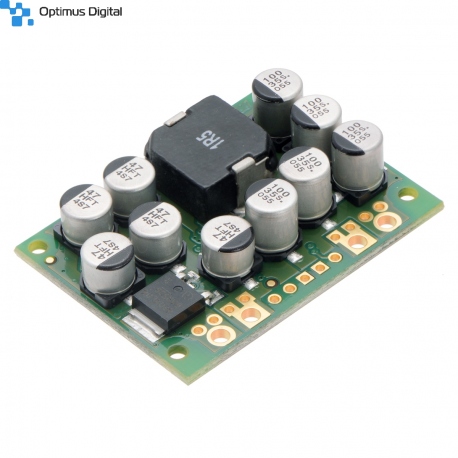 View larger
View larger
5V, 15A D24V150F5 Step-Down Power Supply Module
0104110000024176
New product
This synchronous switching step-down (or buck) regulator takes an input voltage of up to 40 V and efficiently reduces it to 5 V with an available output current of around 15 A. Typical efficiencies of 80% to 95% along with its high current capabilities make this regulator well suited for powering large loads. The regulator features reverse voltage protection and a power-good output that indicates when the regulator cannot adequately maintain the output voltage.
See description for more details about the product.
Add to cart now!
This product is no longer in stock
- Write a review
- Remove this product from my favorite's list.
- Add this product to my list of favorites.
More info
Overview
The D24V150Fx family of step-down voltage regulators are high-current synchronous switching regulators that generate lower output voltages from input voltages as high as 40 V. These types of regulators are also known as switched-mode power supplies (SMPS) or DC-to-DC converters, and they are much more efficient than linear voltage regulators, especially when the difference between the input and output voltage is large. In particular, the D24V150Fx family of regulators have typical efficiencies of 80% to 95%, depending on factors like input voltage, output voltage, and load.
These regulators have an instantaneous current limit of approximately 32 A, but they are limited in the long term to much lower currents by power dissipation and the corresponding temperature rise that induces in the board. The regulators can typically support continuous output currents between 5 A and 20 A without additional cooling (such as with a heat sink or forced airflow), depending on the input voltage and output voltage. In general, the available output current is a little higher for the lower-voltage versions than it is for the higher-voltage versions, and it decreases as the input voltage increases. See the Typical efficiency and output current section at the bottom of this page for more details.
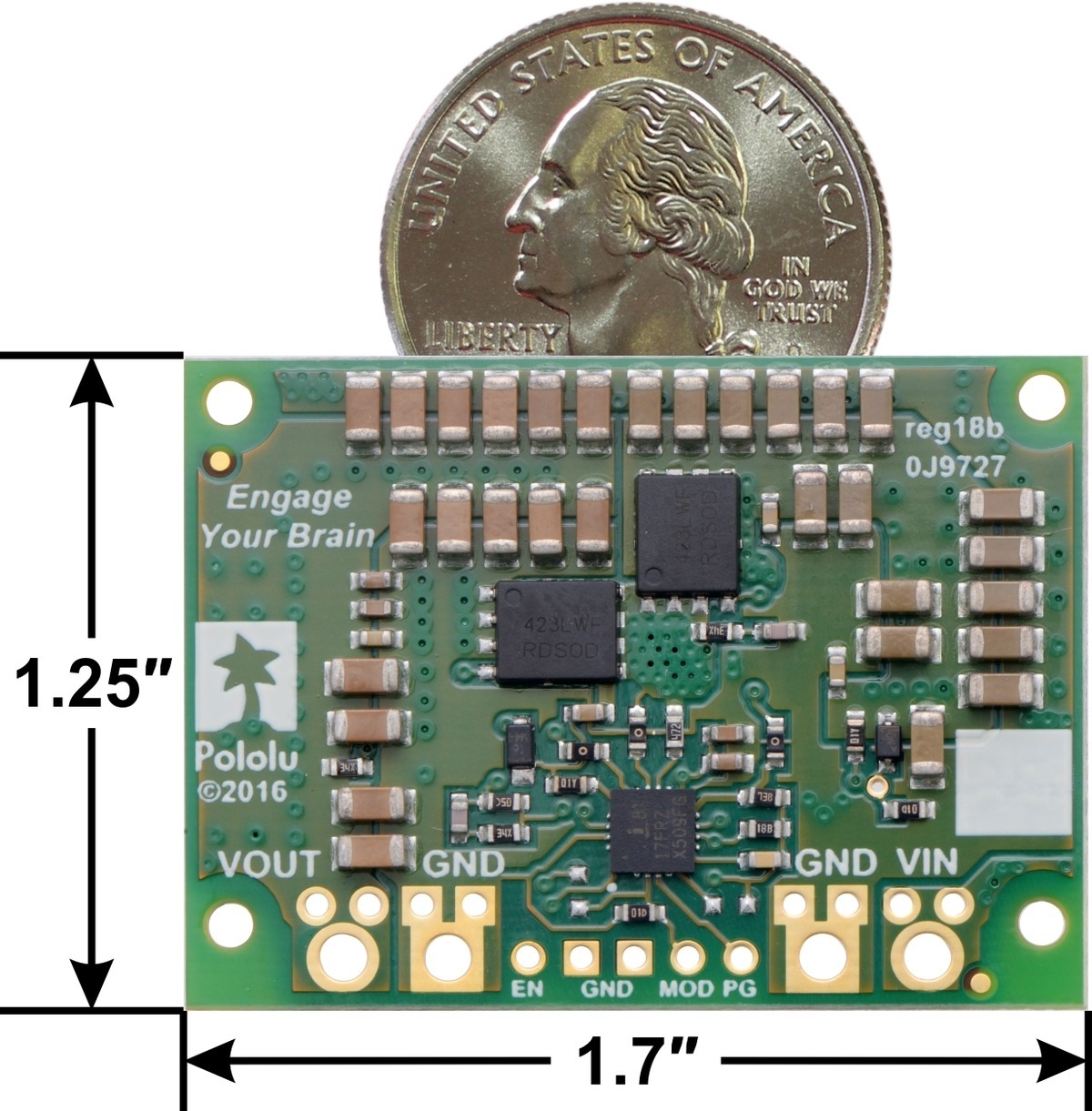
These regulators have a typical quiescent (no load) current draw of around 100 mA, and an enable pin can be used to put the boards in a low-power state that reduces the quiescent current to approximately 5 µA to 10 µA per volt on VIN.
During normal operation, this product can get hot enough to burn you. Even with very light loads, the regulator can run very hot if the input voltage is high, and the higher the input voltage the hotter the regulator will run. Take care when handling this product or other components connected to it.
The modules have built-in reverse-voltage protection, short-circuit protection, a thermal shutdown feature that helps prevent damage from overheating, and a soft-start feature that reduces inrush current. They also feature undervoltage lockout that disables the regulator if the input voltage falls below about 3.5 V.
The different voltage versions of this regulator all look very similar, so you should consider adding your own distinguishing marks or labels if you will be working simultaneously with multiple versions. A white box is provided on the bottom silkscreen of the regulator to make labeling easier.
Features
• Input voltage:
○ 4.5 V to 40 V for the version that outputs 3.3 V
○ [output voltage + dropout voltage] to 40 V for output voltages of 5 V and higher (see below for more information on dropout voltage)
• Fixed 3.3 V, 5 V, 6 V, 7.5 V, 9 V, or 12 V output (depending on regulator version) with 4% accuracy
• Typical maximum continuous output current between 5 A and 20 A
• Typical efficiency of 80% to 95%, depending on input voltage, output voltage, and load
• Integrated reverse-voltage protection, over-current and short-circuit protection, over-temperature shutoff, undervoltage lockout, and soft-start
• Typical no-load quiescent current of 100 mA ; this can be reduced to approximately 5 µA to 10 µA per volt on VIN by disabling the board
• “Power good” output indicates when the regulator cannot adequately maintain the output voltage
• Compact size: 1.7" x 1.25" x 0.43" (43.2 mm x 31.8 mm x 11 mm)
• Four 0.086" mounting holes for #2 or M2 screws
Using the regulator
Connections
These buck regulators have six connections: input voltage (VIN), output voltage (VOUT), enable (EN), power good (PG), mode (MOD), and ground (GND).

The input voltage, VIN, powers the regulator. Voltages between 4.5 V and 40 V can be applied to VIN, but for versions of the regulator that have an output voltage higher than 4.5 V, the effective lower limit of VIN is VOUT plus the regulator’s dropout voltage, which varies approximately linearly with the load (see below for a graph of dropout voltages as a function of the load).
The output voltage, VOUT, is fixed and depends on the regulator version: the D24V150F3 version outputs 3.3 V, the D24V150F5 version outputs 5 V, the D24V150F6 version outputs 6 V, the D24V150F7 version outputs 7.5 V, the D24V150F9 version outputs 9 V, and the D24V150F12 version outputs 12 V.
The regulator’s enable input, EN, is pulled high (to 5 V) internally, which enables the regulator by default. The EN pin can be driven low (under 1 V) to disable the output and put the board into a low-power state. The quiescent current draw in this sleep mode is dominated by the current in an internal pull-up resistor and the reverse-voltage protection circuit, which altogether will draw between 5 µA and 10 µA per volt on VIN when EN is held low. To bring the board out of this low-power state, the EN pin should be pulled above 2 V. If you do not need this feature, you can leave the EN pin disconnected.
The "power good" indicator, PG, is an open-drain output that goes low when the regulator’s output falls below around 85% of the nominal voltage, including when the enable pin is held low, or rises above around 115% of the nominal voltage. Otherwise, the PG pin is high-impedance, so an external pull-up resistor is required to use this pin.
The mode input, MOD, is pulled low internally, which selects fixed-frequency operation by default. This pin can be driven high (above 2 V, but not exceeding 5 V) to override fixed-frequency operation to reduce quiescent current (and therefore to increase efficiency) at light loads (on the order of a few milliamps). This reduced-power feature is available when the input voltage is substantially higher than the output voltage (see the item-specific details section at the bottom of this page for more information).
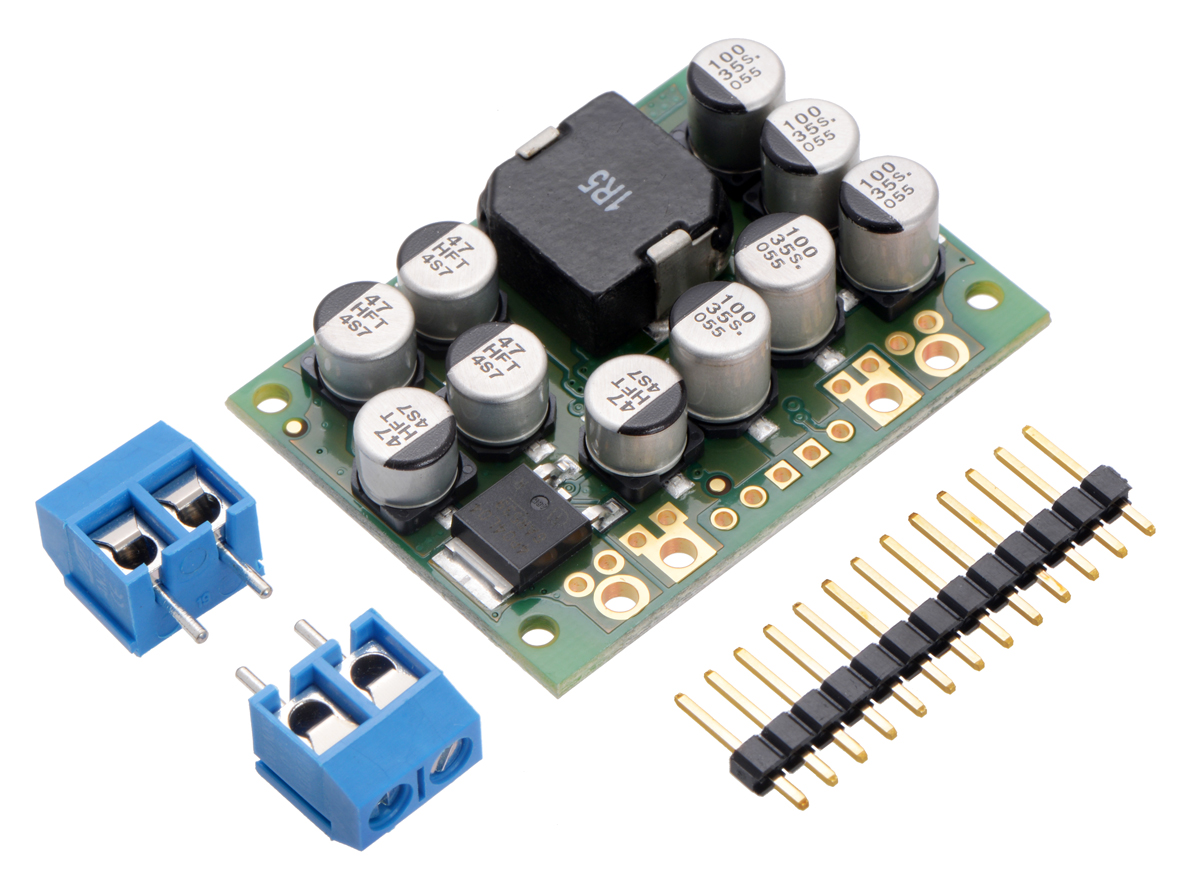
Pololu Step-Down Voltage Regulator D24V150Fx with included hardware.
The connections are labeled on the back side of the PCB, and the board offers several options for making electrical connections. The three sets of smaller through-holes are arranged with a 0.1" spacing for compatibility with solderless breadboards, connectors, and other prototyping arrangements that use a 0.1" grid; you can solder pieces of 13x1 straight male header strip into these smaller holes. Alternatively, you can solder the 2-pin 5mm-pitch terminal blocks to the two pairs of larger holes. For the most compact installation, you can solder wires directly to the board.

Pololu Step-Down Voltage Regulator D24V150Fx in a breadboard, assembled with terminal blocks and male headers.
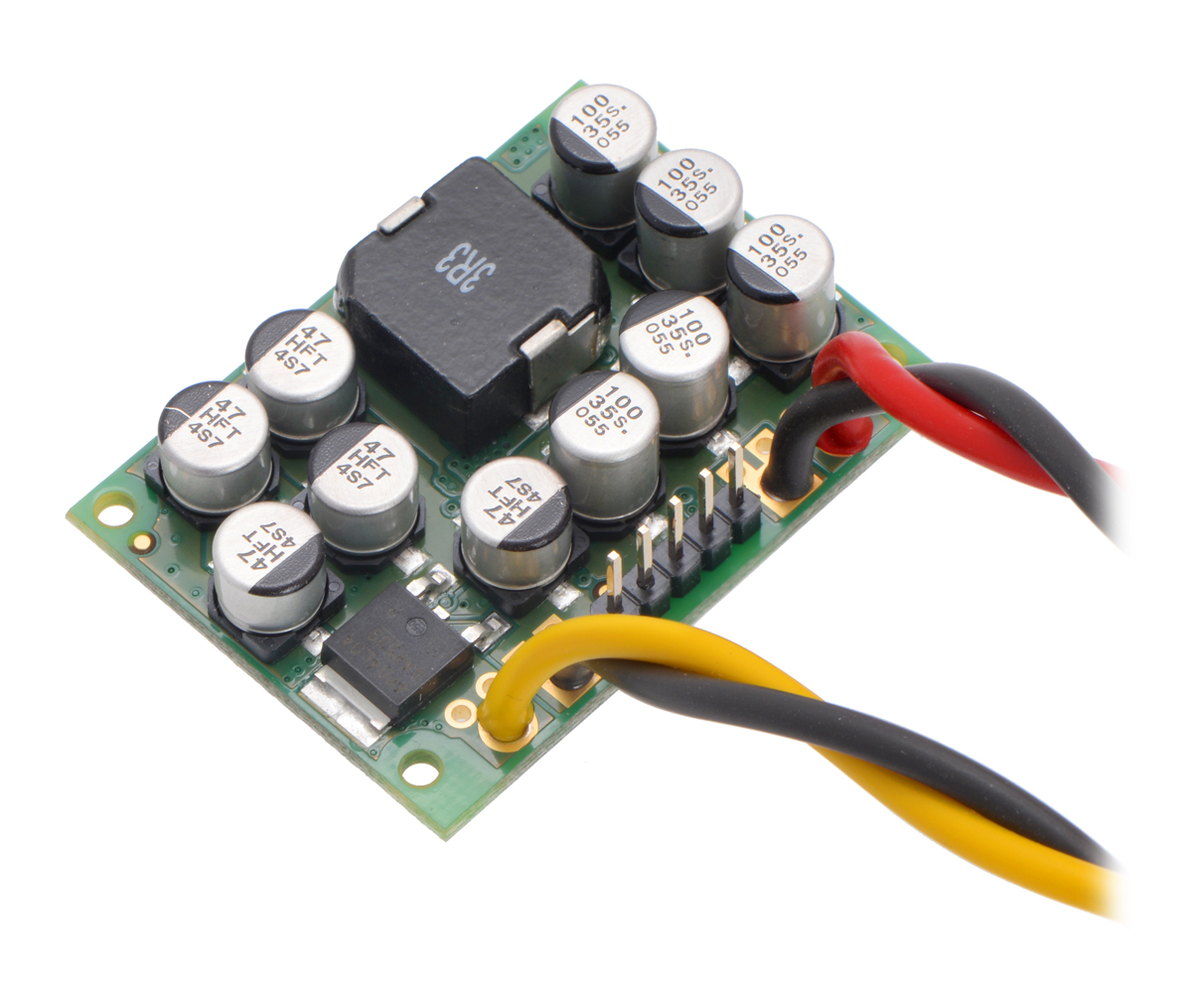
Pololu Step-Down Voltage Regulator D24V150Fx showing wires soldered directly to the board.
The board has four 0.086" mounting holes intended for #2 or M2 screws. The mounting holes are in the four corners of the board and are separated by 1.53" horizontally and 1" vertically. For all the board dimensions, see the dimension diagram (307k pdf).
Typical efficiency and output current
The efficiency of a voltage regulator, defined as (Power out)/(Power in), is an important measure of its performance, especially when battery life or heat are concerns. This family of switching regulators typically has an efficiency of 80% to 95%, though the actual efficiency in a given system depends on input voltage, output voltage, and output current. See the efficiency graph near the bottom of this page for more information.
The maximum achievable continuous output current is typically between 5 A and 20 A, but this depends on many factors, including the ambient temperature, air flow, heat sinking, and the input and output voltage. See the continuous output current graph near the bottom of this page for more information. The maximum instantaneous current is limited to approximately 32 A.
Typical dropout voltage
The dropout voltage of a step-down regulator is the minimum amount by which the input voltage must exceed the regulator’s target output voltage in order to ensure the target output can be achieved. For example, if a 5 V regulator has a 1 V dropout voltage, the input must be at least 6 V to ensure the output is the full 5 V. Generally speaking, the dropout voltage increases as the output current increases. See the "Details" section below for more information on the dropout voltage for this specific regulator version.
Details
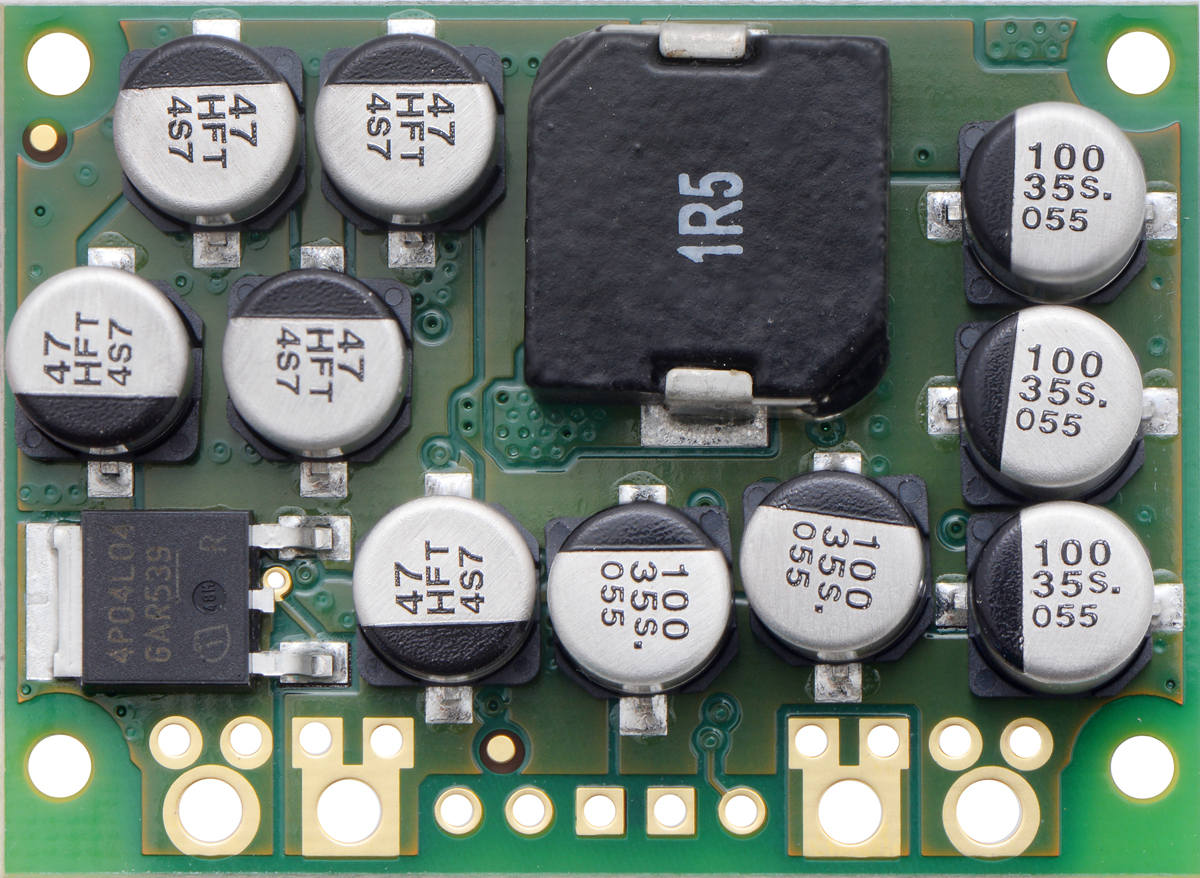
Pololu 5V, 15A Step-Down Voltage Regulator D24V150F5, top view.
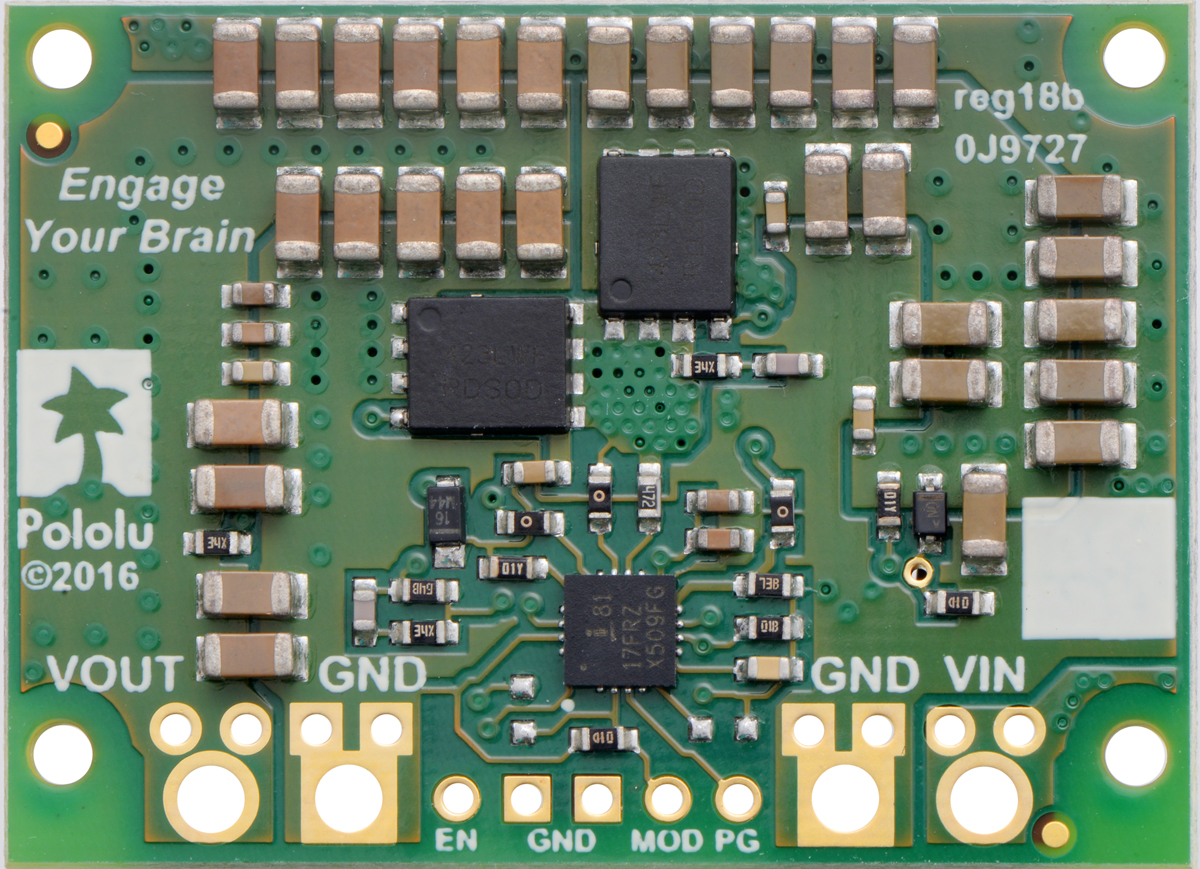
Pololu 5V, 15A Step-Down Voltage Regulator D24V150F5, bottom view.
The graphs below show the typical efficiency, maximum continuous current, and dropout voltage of the 5 V D24V150F5 regulator:

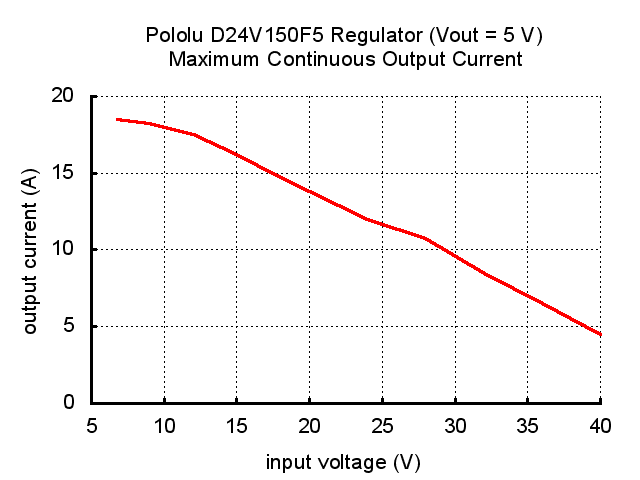
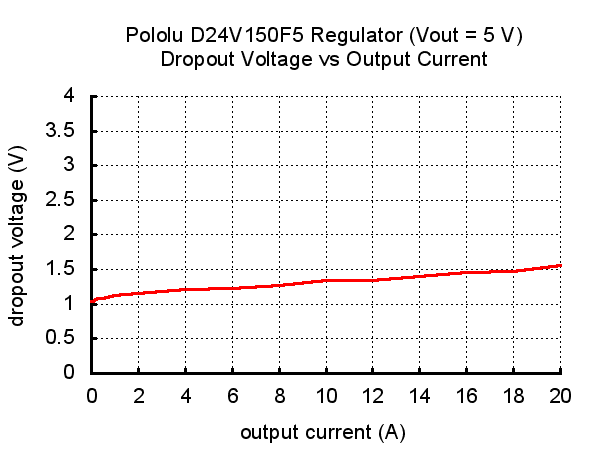
Power-save mode for the 5V version
For this 5 V regulator version, the power-save mode is available for input voltages above 12 V. See the Connections section above for details on the MOD pin, which is used to activate this mode.
Specifications
Dimensions
| Size: | 1.7" x 1.25" x 0.43"1 |
| Weight: | 19 g1 |
General specifications
| Minimum operating voltage: | 6 V2 |
| Maximum operating voltage: | 40 V |
| Continuous output current: | 15 A3 |
| Output voltage: | 5 V |
| Reverse voltage protection?: | Y |
| Maximum quiescent current: | 100 mA4 |
Notes:
1 Without included optional hardware.
2 For small loads; this voltage rises approximately linearly up to around 6.5 V at 15 A output.
3 This value is mainly for comparison to our other regulators. Actual achievable continuous output current is a function of input voltage and is limited by thermal dissipation. See the output current graph under the description tab for more information.
4 Typical maximum for the higher end of the input voltage range; it is a little lower at lower voltages. The ENABLE pin can be used to reduce the quiescent current to less than 10 μA per volt on VIN.
Don't delay, buy today.
Add to cart now!
Reviews
Customers who bought this product also bought:
-
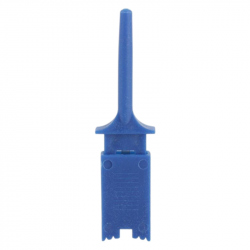
SMD Test...
These are test clips made of plastic which can...
$0.31
-
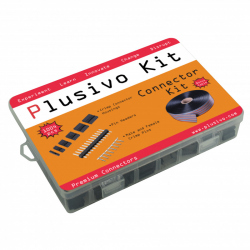
Connector...
Complete Connector Kit: single row pin...
$14.40
-
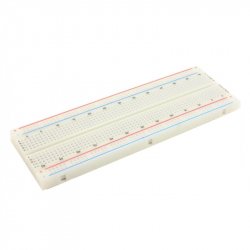
Breadboard...
This high quality 830 point breadboard is made...
$2.40
-
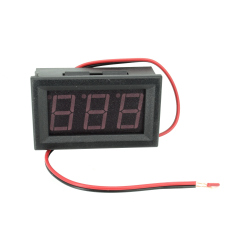
2 Wire DC...
This 2-wire DC voltmeter panel is a highly...
$2.48
-
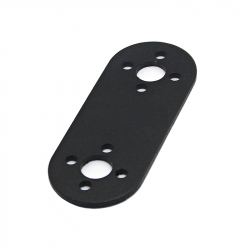
63mm...
63mm FK-YS-001 Aluminium Connection Board
$3.60
-
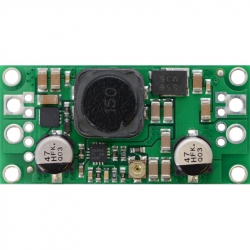
Pololu...
This powerful step-up/step-down regulator...
$18.72
-
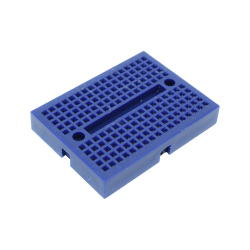
SYB-170...
Colored mini breadboard, ideal for small...
$0.57
-
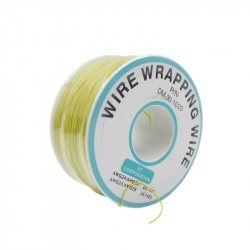
250 m Yellow...
250 m Yellow Wire Mini Roll 0.5 mm External...
$7.20
-
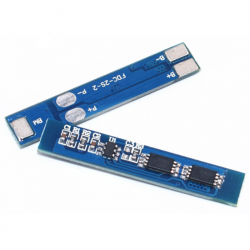
2-Cell...
This card is used for Li-Ion batteries. The...
$0.83
-
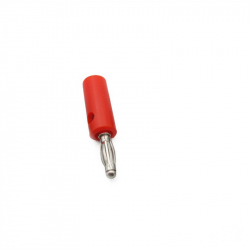
Red Banana Plug
Banana plug - red color, for DC voltages...
$0.23




